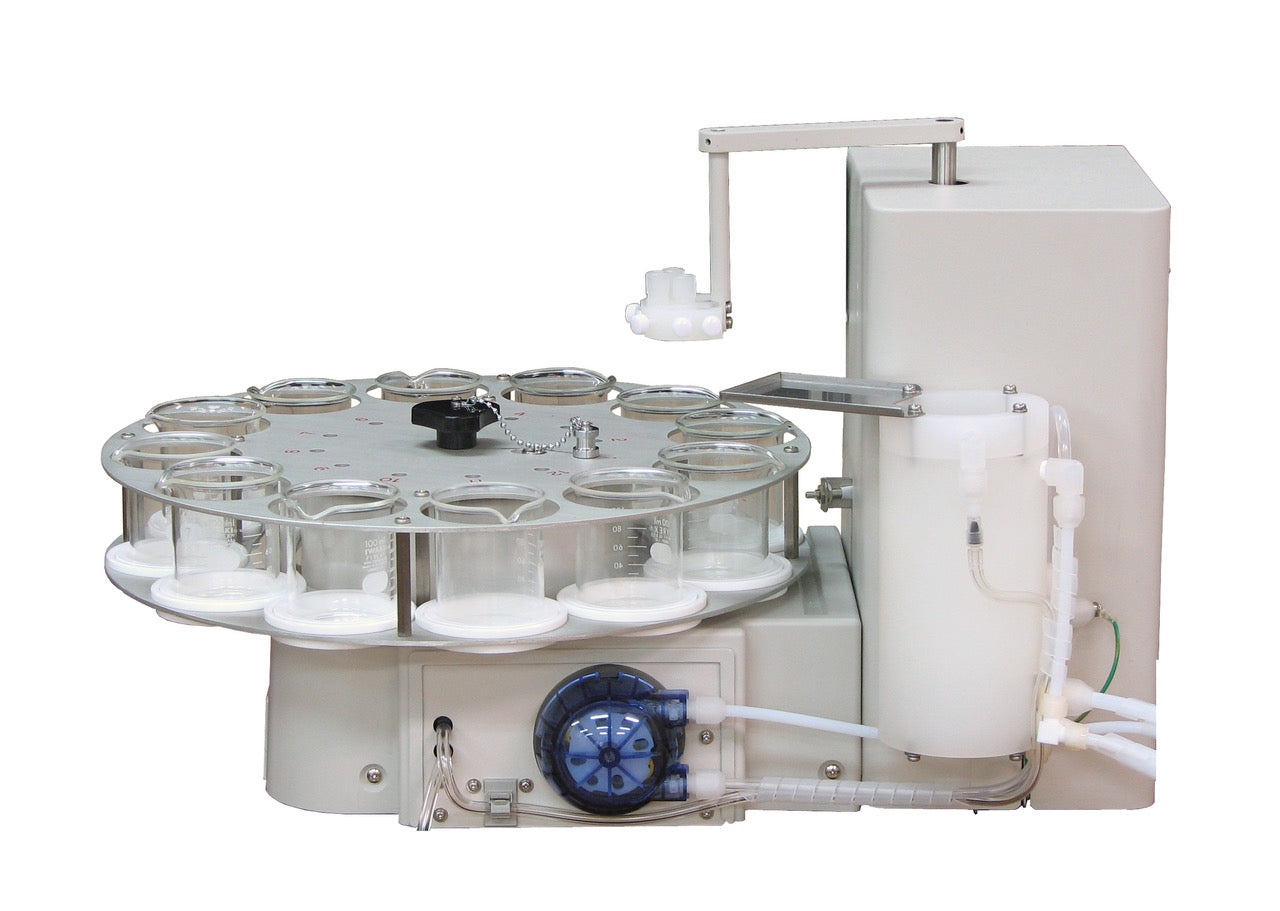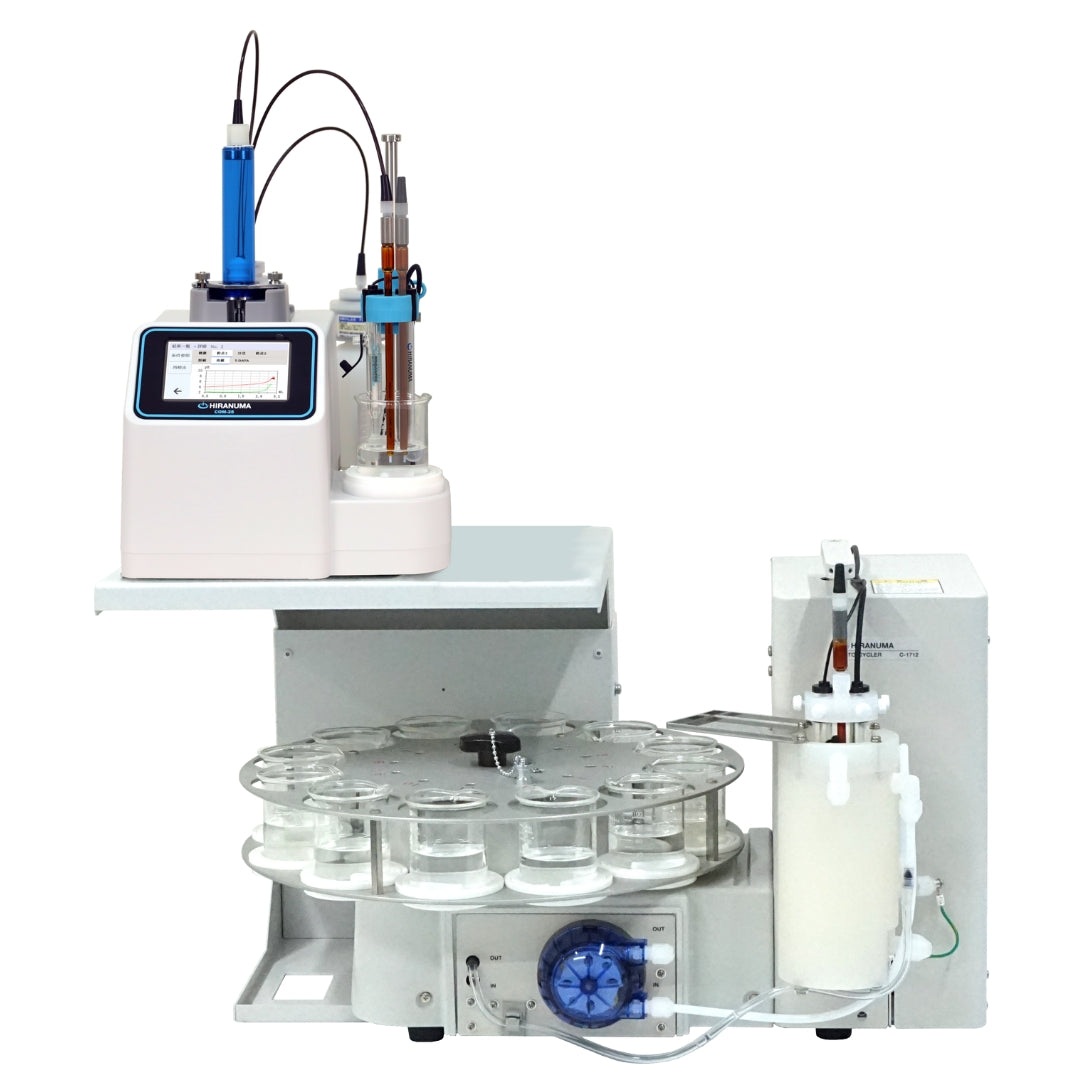| HIRANUMA APPLICATION DATA | Automatic Titrator | Data No. | H6 | Apr. 5,2019 |
| SODA PULP INDUSTRY | Determination of sodium chloride in sodium hypochlorite |
1. Abstract
Sodium hypochlorite is produced by having sodium hydroxide absorb chlorine gas. Produced sodium hypochlorite contains residual alkali (sodium hydroxide, sodium carbonate) and sodium chloride generated by the degradation of hypochlorous acid. The residual alkali is determined by neutralization titration, and sodium chloride is determined by precipitation titration.
This report introduces an example of the determination for sodium chloride in the sodium hypochlorite with potentiometric titration as the following procedure: the titration for the total chlorine component (sodium hypochlorite + sodium chloride) is performed first. After that, sodium hypochlorite (available chlorine) is titrated by another method. Finally, sodium chloride is determined by the subtraction of sodium hypochlorite from the total chloride component.
The total sodium chloride (total chloride component) is determined according to the following formula (1) and (2): add hydrogen peroxide into a sample to degrade sodium hypochlorite, and generate sodium chloride as described in formula (1). Titrate with nitric acid standard solution until the pH goes down to 2 ~ 3. After the solution is acidified, determine the total sodium chloride with silver nitrate standard solution by precipitation titration as formula (2).
| NaClO + H₂O₂ → NaCl + H₂O + O₂ | ・・・(1) |
| NaCl + AgNO₃ → AgCl + NaNO₃ | ・・・(2) |
Regarding the determination of available chlorine, free iodine generated by the addition of potassium iodide as described in formula (3) is determined with sodium thiosulfate standard solution by redox titration as shown in formula (4).
| NaClO + 2KI ± H₂O → I₂ + NaCl + 2KOH | ・・・(3) |
| I₂ + 2Na₂S₂O₃ → 2NaI + Na₂S₄O₆ | ・・・(4) |
2. Configuration of instruments and Reagents
| (1) | Configuration of instruments | ||
| Main unit | : | Hiranuma Automatic Titrator COM series | |
| Option | : | One buret, one buret head | |
| Electrodes | : | [For total sodium chloride] Glass electrode GE-101B Silver combination electrode AGR-811Z (Double junction type) [For available chlorine] Platinum electrode PT-301 Reference electrode RE-201Z |
|
| (2) | Reagents | ||
| [For total sodium chloride] | |||
| Titrant | : | 0.2 mol/L Silver nitrate standard solution 0.1 mol/L Nitric acid standard solution |
|
| Additive | : | 3 % Hydrogen peroxide solution | |
| [For available chlorine] | |||
| Titrant | : | 0.2 mol/L Sodium thiosulfate standard solution | |
| Additive | : | 10 % Potassium iodide solution 2 mol/L Acetic acid solution |
|
3. Measurement procedure
| (1) | Measurement for total sodium chloride (i) Dispense 0.5 mL of sample into a 100 mL beaker with micropipette. (ii) Add 50 mL of DI water. (iii) Add 5 mL of 3 % hydrogen peroxide solution and degrade sodium hypochlorite. (iv) Immerse the electrodes (GE-101B/AGR-811Z) into sample solution. Titrate with 0.1 mol/L nitric acid standard solution and adjust the pH to 2 ~ 3. (v) Titrate with 0.2 mol/L silver nitrate standard solution. |
| (2) | Measurement for available chlorine (i) Dispense 0.5 mL of sample into a 100 mL beaker with micropipette. (ii) Add 50 mL of DI water. (iii) Add 1 mL of 10 % potassium iodide solution. (iv) Add 10 mL of 2 mol/L acetic acid solution. (v) Immerse electrodes (PT-301/RE-201Z) and titrate with 0.2 mol/L sodium thiosulfate standard solution. |
4. Measurement conditions and results
Examples of titration conditions
(1) Measurement for total sodium chloride
(i) Titration with 0.1 mol/L nitric acid standard solution
| Cndt No | 1 | |
| Method | Set | |
| Buret No. | 1 | |
| Amp No. | 1 | |
| D. Unit | pH | |
| S-Timer | 5 | sec |
| C.P. mL | 0 | mL |
| Direction | ↓ | |
| T Timer | 0 | sec |
| D.P. mL | 0 | mL |
| End Point | 3 | pH |
| Over mL | 0 | mL |
| Max Vol. | 20 | mL |
| Constant No. | 1 | |
| Size | 0.5 | mL |
| Blank | 0 | mL |
| Molarity | 0.1 | mol/L |
| Factor | 1.004 | |
| K | 0 | |
| L | 0 | |
| Unit | mL | |
| Formula | D | |
| Decimal Places | 3 | |
|
Auto In Pram.
|
None | |
| Mode No. | 4 | |
| Pre Int | 0 | sec |
| Del K | 9 | |
| Del Sens | 0 | mV |
| Int Time | 3 | sec |
| Int Sens | 3 | mV |
| Brt Speed | 2 | |
| Pulse | 40 |
(ii) Titration with 0.2 mol/L silver nitrate standard solution
| Cndt No | 2 | |
| Method | Auto | |
| Buret No. | 2 | |
| Amp No. | 2 | |
| D. Unit | mV | |
| S-Timer | 5 | sec |
| C.P. mL | 0 | mL |
| T Timer | 0 | sec |
| D.P. mL | 0 | mL |
| End Sens | 100 | |
| Over mL | 0.2 | mL |
| Max Vol. | 20 | mL |
| Constant No. | 2 | |
| Size | 0.5 | mL |
| Blank | 0 | mL |
| Molarity | 0.2 | mol/L |
| Factor | 1 | |
| K | 58.44 | |
| L | 0 | |
| Unit | % | |
| Formula | (D-B)*K*F*M/(S*10) | |
| Decimal Places | 4 | |
|
Auto In Pram.
|
None | |
| Mode No. | 8 | |
| Pre Int | 0 | sec |
| Del K | 5 | |
| Del Sens | 0 | mV |
| Int Time | 5 | sec |
| Int Sens | 3 | mV |
| Brt Speed | 2 | |
| Pulse | 40 | |
(2) Measurement for available chlorine (Calculation of sodium chloride concentration)
(i)Titration with 0.2 mol/L sodium thiosulfate standard solution
| Cndt No. | 3 | |
| Method | Auto | |
| Buret No. | 1 | |
| Amp No. | 2 | |
| D. Unit | mV | |
| S-Timer | 5 | sec |
| C.P. pH | 0 | mL |
| T Timer | 0 | sec |
| D.P. mL | 0 | mL |
| End Sens | 200 | |
| Over mL | 0.3 | mL |
| Max Vol. | 20 | mL |
| ConstantNo. | 3 | |
| Size | 0.5 | mL |
| Blank | 0 | mL |
| Molarity | 0.2 | mol/L |
| Factor | 1.002 | |
| K | 35.45 | |
| L | 0 | |
| Unit | % | |
| Formula | (D-B)*K*F*M/(S*10) | |
| Decimal Places | 4 | |
|
Auto In Pram.
|
None | |
| Mode No. | 5 | |
| Pre Int | 0 | sec |
| Del K | 5 | |
| Del Sens | 0 | mV |
| Int time | 3 | sec |
| Int Sens | 3 | mV |
| Brt Speed | 2 | |
| Pulse | 40 | |
(ii) Calculation of sodium chloride concentration
| Cndt No. | 4 | |
| Method | Calc | |
| ConstantNo. | 4 | |
| Size | 0.5 | mL |
| Blank | 0 | mL |
| Molarity | 0.2 | mol/L |
| Factor | 0 | |
| K | 14.8 | *1 |
| L | 0.8243 | *2 |
| Unit | % | |
| Formula | K-CA*L | |
| Decimal Places | 4 | |
|
Auto In Pram.
|
None |
*1 Input the result of total sodium chloride.
*2 Conversion coefficient from available chlorine to sodium chloride (58.44(NaCl)/70.9(Cl2))
Measurement results
(1) Results of total sodium chloride
| Number of measurement |
Size (mL) |
Titrant Volume(mL) |
Total sodium chloride Concentration (%) |
|---|---|---|---|
| 1 | 0.5 | 6.329 | 14.795 |
| 2 | 0.5 | 6.324 | 14.783 |
| 3 | 0.5 | 6.339 | 14.818 |
| Statistic calculation |
Avg. | 14.80 % | |
| SD | 0.02 % | ||
| RSD | 0.12 % | ||
(2) Results of available chlorine (Calculated results of sodium chloride concentration)
| Number of measurement |
Size (mL) |
Titrant volume (mL) |
Available chlorine Concentration (%) |
Sodium chloride Concentration (%) |
|---|---|---|---|---|
| 1 | 0.5 | 10.174 | 14.456 | 2.884 |
| 2 | 0.5 | 10.223 | 14.525 | 2.827 |
| 3 | 0.5 | 10.276 | 14.601 | 2.765 |
| Statistic calculation |
Average | 14.52 % | 2.83 % | |
| Standard deviation | 0.07 % | 0.06 % | ||
| Coefficient of variation | 0.50 % | 2.11 % | ||
Examples of titration curves
|
|
|
Measurement for total sodium chloride |
Measurement for available chlorine |











